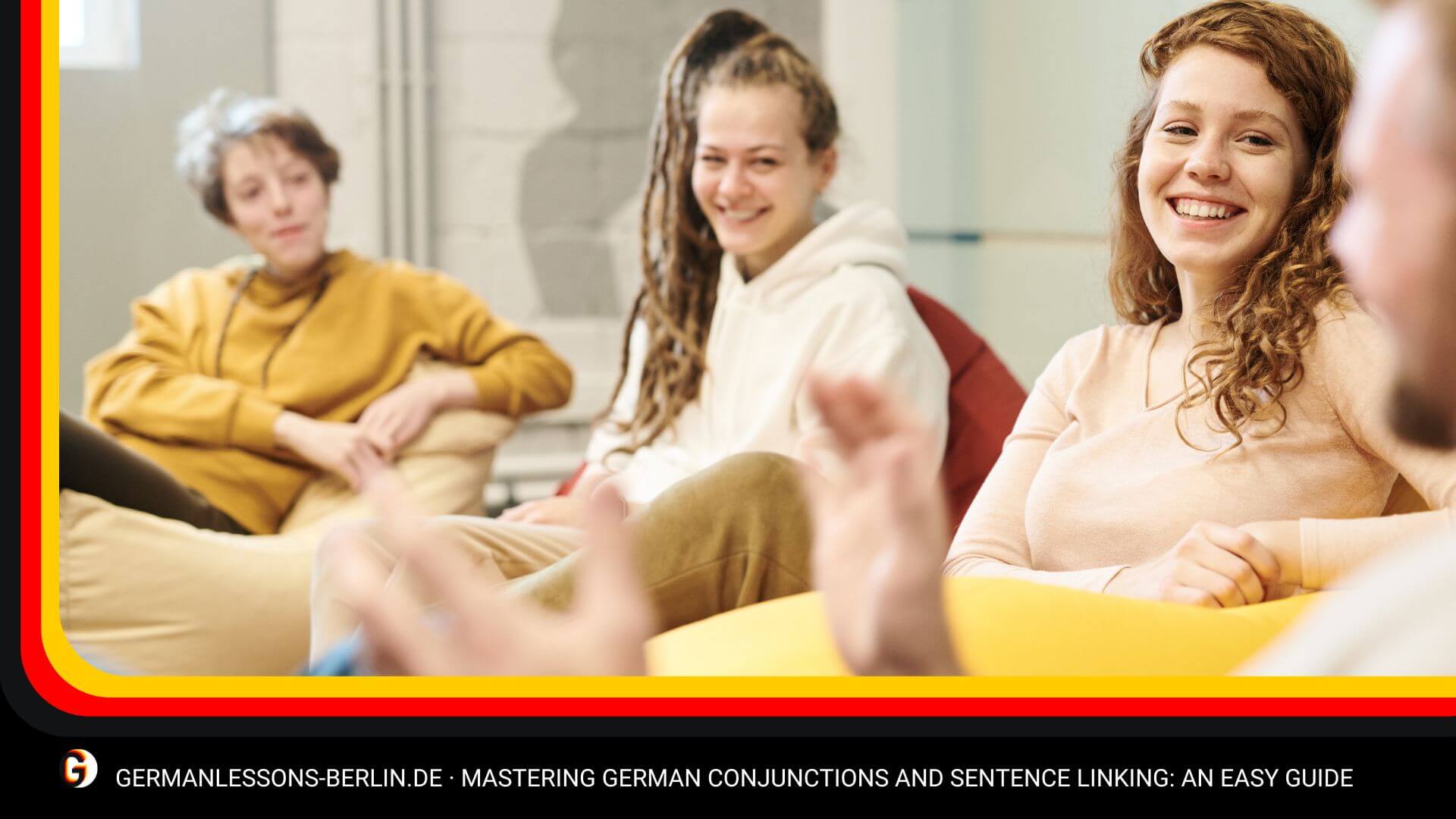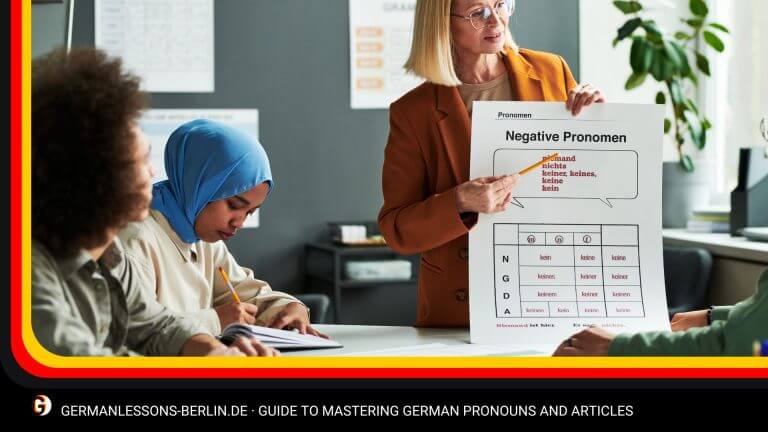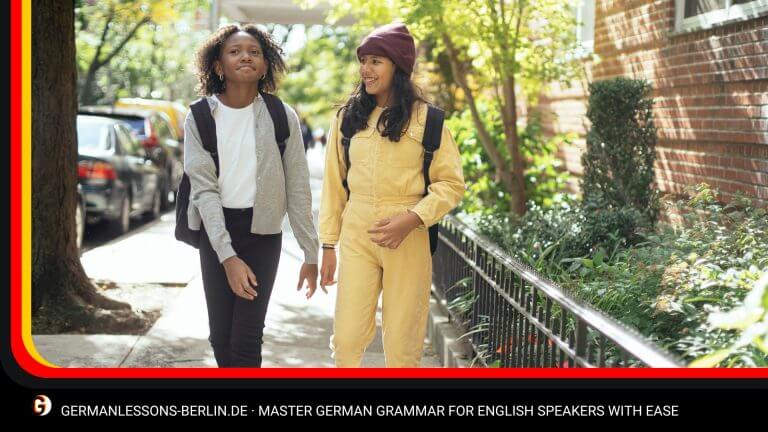As someone who’s ventured into the fascinating world of language learning, I’ve found the rich complexities of German grammar riveting. German conjunctions, posing a unique challenge to learners, are pivotal in mastering sentence linking and the intricacies of the German grammar guide. They are the cogs that interlink thoughts coherently, distinguishing proficient speakers from novices. Integrating conjunctions in German is akin to weaving the threads of conversation, creating a seamless tapestry of language that showcases eloquence and fluidity in expression.
However, like many, my initial forays into German sentence construction were met with a tangle of syntactic threads. Grappling with the perfect blend of words for expression has been a rewarding challenge. To unravel this, I realized that it wasn’t just about memorizing conjunctions and adverbs, but understanding their strategic placement in sentences. This guide serves as an ally to assist fellow linguists in structuring their German narratives with the elegance it deserves.
Key Takeaways
- Grasping German conjunctions is essential for fluid sentence linking in the language.
- A firm grip on German sentence structure vastly improves communication skills.
- Coordinating and subordinating conjunctions differ in rank and influence on word order.
- Understanding verb positions within relative clauses and modal verbs is crucial.
- Adverbs and adverbial phrases elevate the clarity and depth of sentences.
- An available PDF guide offers practice exercises to hone these skills.
The Importance of Conjunctions in German Language
When I embarked on learning German, I quickly grasped that the art of connecting sentences in German hinges significantly on the adept use of conjunctions. These linguistic tools are the invisible bonds that tie individual phrases into the complex textures of conversation and narration. In exploring the German language structure, I was struck by the vitality of conjunctions—without them, ideas remain isolated; with them, a narrative unfolds.
Coordinating conjunctions hold a special place, promoting reciprocity between clauses of equal grammatical rank. They are the democratic elements of sentence structure, treating each connected clause with equivalent importance and thereby retaining the original word order.
- und (and)
- oder (or)
- aber (but)
- denn (for/because)
In stark contrast, subordinating conjunctions create a hierarchy of ideas, altering the word order to signify the subordinate nature of the clause that follows. This shift in structure emphasizes the dependent relationship between the clauses, propelling a sentence from simple to complex.
- weil (because)
- obwohl (although)
Witnessing the impact of conjunction usage on sentence fluency and complexity, I’ve come to appreciate the delicate balancing act they perform in German composition. Now, let’s delve into a comparative analysis of these conjunction types:
| Conjunction Type | Role in Sentences | Effect on Word Order |
|---|---|---|
| Coordinating | Link equal clauses | Retains the original SVO order |
| Subordinating | Introduce dependent clauses | Moves main verb to sentence end |
Through my learning journey, I’ve come to understand that the role of conjunctions in the German language is not merely functional but transformative. They not only bridge isolated thoughts but also dictate the flow and rhythm of our conversations. In the intricate dance of German grammar, conjunctions lead, and sentences follow.
Understanding Basic German Word Order
When I first dived into the waters of learning German, the sentence structure was one of the aspects that struck me as both familiar and unique. With guidance, I discovered the SVO word order, a common foundation shared with English. The revelation that the verb always snags the second position in basic German grammar was a game-changer for me. It’s like having a reliable anchor point, from which everything else revolves.
The Simple SVO Structure
A textbook sentence in German follows the Subject-Verb-Object order, similar to English. This structure creates a direct and clear framework for communication. For instance, when I say “Ich werfe den Ball” (I throw the ball), it’s a straightforward SVO sentence with Ich as the subject, werfe as the verb in the second position, and den Ball as the object.
Switching Between Subject and Object
However, German word flexibility allows for the subject and object to change positions, adding a layer of sentence emphasis in German that is less common in English. Take this sentence as an example: “Den Film kenne ich nicht” (I don’t know that film). It places the object “Den Film” at the beginning for emphasis while the subject “ich” follows the verb. The altering of the object and subject positioning is German’s subtle art of shifting emphasis while keeping communication intact.
Verb Position and Sentence Emphasis
One of the hallmarks of German sentence emphasis is maintaining the position of the verb. No matter which component of the sentence comes first, the verb confidently occupies the second slot. This applies even when leading with adverbial phrases, altering the information hierarchy without breaking the fundamental rule of verb positioning. For example, starting a sentence with an adverb phrase:
Nächste Woche kaufen wir ein neues Auto.
(Next week, we are buying a new car.), we see the priority of the verb position echoed as the sentence is crafted for directional emphasis while adhering to the basic German grammar.
The consistent positioning of verbs is indeed a testament to the German language’s structured approach that guides learners to understand and emphasize the right elements in their sentences.
- In German, the verb is the immovable centerpiece of sentence construction.
- Switching the subject and object can significantly change the sentence’s connotation.
- Even when leading with adverbs, the verb retains its second position, often to give contextual emphasis.
| Construction | Example | Emphasis |
|---|---|---|
| Basic SVO | Ich werfe den Ball. | Neutral |
| Object first | Den Film kenne ich nicht. | Emphasis on Object |
| Leading with adverb | Nächste Woche kaufen wir ein neues Auto. | Temporal focus |
The German sentence structure, with all its rules and flexibility, turns your expressions from simple statements into rich, meaningful dialogue. It’s like having a “linguistic toolkit” at your disposal, allowing you to construct your thoughts with precision and intention.
Navigating Coordinating Conjunctions
Unlocking the flow of German conversation involves grasping the subtle yet critical use of German coordinating conjunctions. As I learned more about the German language, it became evident that these elements play a crucial role in connecting equal sentences without altering their word order. This is essential for anyone looking to express complex ideas clearly and effectively in German.
Let’s explore some conjunction examples that illustrate the seamless connection that coordinating conjunctions allow between ideas:
- und (and)
- oder (or)
- aber (but)
- denn (because/for)
These conjunctions function as linguistic glues, always maintaining the Subject-Verb-Object (SVO) order in sentence pairs. When I joined my first German conversation group, I noticed how fluently sentences were interwoven, thanks to these conjunctions. The following tables demonstrate the unchanged SVO order when employing coordinating conjunctions in real-world examples:
| Conjunction | Sentence Pair Joined | Structure Maintained |
|---|---|---|
| und | Ich spiele Gitarre und ich singe dazu. | SVO + SVO |
| oder | Möchtest du Kaffee oder Tee trinken? | SVO + SVO |
| aber | Er wollte mitkommen, aber er muss arbeiten. | SVO + SVO |
| denn | Wir bleiben zu Hause, denn es regnet. | SVO + SVO |
By using coordinating conjunctions, you’ll find that your ability to link thoughts becomes more intuitive, deepening your understanding of German grammar in action. For me, mastering these conjunctions was not just a linguistic requirement but a doorway to engaging fully in German discourse, allowing my thoughts to be expressed with clarity and logical continuity.
Cracking the Code of Subordinating Conjunctions
Embarking on my German language journey, I’ve encountered a fascinating feature that showcases German grammar in action: German subordinating conjunctions. These conjunctions entail more than mere linking words; their usage deftly repositions verbs, altering sentence structures profoundly. It’s an undeniably tricky aspect to master, but insight into this mechanism is a revelation for logical communication and nuanced expression.
Understanding this puzzle of German subordinating conjunctions demands a foray into the world of verb positioning. By deftly placing verbs at the end of clauses, a layered manner of speech emerges, enriching statements with depth and deference to the primary clause.
Changing the Game with Verb Position
When integrating German subordinating conjunctions into sentences, the main verb is thrust to the concluding position. This transformation does more than modify sentence architecture; it casts new light on the verb’s role, compelling it to take a backseat to the point being articulated. My encounter with this element of German syntax unlocked a new dimension to my sentence construction, supporting more intricate narratives.
Examples to Illustrate Subordinating Conjunctions in Action
Let’s explore some of the most prolific players in the realm of German subordinating conjunctions. Notice below how they invoke verb repositioning, altering the emphasis and flow of the sentences:
- weil (because)
- obwohl (although)
In instances when I wield the conjunction weil, I’m compelled to place the verb at the end. Here’s an illustration:
Ich mache meine Hausaufgaben, weil ich für die Prüfung lernen muss.
(I’m doing my homework because I need to study for the test.)
Conversely, with the addition of obwohl, a similar shift is manifested:
Obwohl ich müde bin, gehe ich ins Fitnessstudio.
(Although I am tired, I am going to the gym.)
This strategic repositioning echoes throughout sentences with subordinating conjunctions, delivering a measured, thoughtful progression of ideas. In the carefully orchestrated dance of German sentence construction, these examples of subordinating conjunctions cue the verb to gracefully exit stage right, paving the way for a harmonious finish.
| Subordinating Conjunction | Original Sentence Structure | With Conjunction |
|---|---|---|
| weil | Ich muss für die Prüfung lernen. | Ich mache meine Hausaufgaben, weil ich für die Prüfung lernen muss. |
| obwohl | Ich bin müde. | Obwohl ich müde bin, gehe ich ins Fitnessstudio. |
The comprehension of these conjunctions promises the seasoned German speaker a new echelon of expressiveness. With verbs positioned as the concluding act of a clause, the prior information is rightfully underscored, propelling speech that is rich with intention and clarity.
Exploring Other German Verb Position Scenarios
In the realm of German grammar, verb position variations complicate the sentence structure beyond the basic SVO (Subject-Verb-Object) framework, presenting unique challenges and opportunities for linguistic sophistication. My experiences with German complex sentences have unveiled scenarios where the verb diverges from its conventional second position, opening the door to richer and more nuanced expressions. Let’s navigate through the subtleties of scenarios such as relative clauses and the usage of modal verbs through concrete examples.
Verb Position in Relative Clauses
While immersing myself in German literature, I encountered an intriguing aspect of verb positioning—when a sentence includes a relative clause, the verb it contains takes the final position. This reshuffling occurs regardless of whether the clause is necessary for the meaning of the sentence (defining) or just provides extra information (non-defining).
Discovering the intricacies of this structure highlighted the importance of relative clauses in crafting German complex sentences. Let’s analyze an example to see this practice in action:
Ich kenne jemanden, der das Problem lösen kann.
(I know someone who can solve the problem.)
In the relative clause “der das Problem lösen kann“, the verb “kann” takes its place at the end. I’ve observed that this rule lends a certain rhythmic closure to the sentence, placing emphasis on the action within the clause.
Modal Verbs Outside of the Second Position
My breakthrough with modal verbs came when I understood their role in expressing necessity, permission, desire, or ability. As auxiliary verbs, they live harmoniously with another verb in the sentence, which is pushed to the end in its infinitive form. Here’s an example:
Ich muss meine Hausaufgaben machen.
(I must do my homework.)
The verb “machen” is shunted to the back of the bus, emphasizing the necessity denoted by the modal verb “muss”. Mastering this nuanced rule presented a thrilling achievement, deepening my understanding of verb position variations in German sentences.
| Non-Modal Sentence | With Modal Verb | Verb Position |
|---|---|---|
| Ich mache meine Hausaufgaben. | Ich muss meine Hausaufgaben machen. | Modal verb ‘muss’ second; main verb ‘machen’ at end |
| Wir gehen ins Kino. | Wir möchten ins Kino gehen. | Modal verb ‘möchten’ second; main verb ‘gehen’ at end |
The above table displays how verb positioning transforms when modal verbs enter the scene, fundamentally altering sentence dynamics.
Having voyaged through the varied landscapes of German verb position scenarios, I’ve come to appreciate the depth and flexibility inherently woven into the fabric of this language. These forays into complex sentence construction aren’t merely grammatical exercises; they’re opportunities to craft messages with intent and finesse.
Introducing Adverbs and Adverbial Information
Immersing myself into the complexities of the German language, I’ve found that German adverbs and adverbial phrases play an instrumental role in providing sentence details that paint a more vivid picture for the listener or reader. Understanding where these adverbial elements fit within a sentence can enhance expression significantly, and one guiding principle I’ve come to rely on is called TeKaMoLo.
TeKaMoLo—an acronym for Temporal, Kausal, Modal, and Lokal—plays a crucial role in the ordering of adverbial information, establishing a framework for detailing when, why, how, and where an action occurs in a German sentence. Let me share how each of these principles folds into practical use:
- Temporal adverbs answer the question “Wann?” signaling when something happens. These adverbs often lead the sentence to set the time context right from the start. For example, “Gestern habe ich ein Konzert besucht” (Yesterday, I attended a concert).
- Kausal adverbs bring forth the reason or cause, responding to “Warum?” They provide a motive as in “Der Zug war verspätet, wegen des Sturms” (The train was delayed because of the storm).
- Modal adverbs express the manner or way in which something is done, answering “Wie?” such as in “Sie spricht fließend, ohne Mühe” (She speaks fluently, effortlessly).
- Lokal adverbs pinpoint location, answering “Wo?” or “Wohin?” like “Ich gehe heute ins Kino” (I am going to the cinema today).
Naturally, sticking to the TeKaMoLo order is important for me as I express myself in German—it keeps my statements clear and precise, and mirrors the way native speakers construct their sentences.
The following table further demonstrates the TeKaMoLo principle by providing examples for each type of adverbial information in a German sentence:
| Type | German Term | Question | Sample Sentence |
|---|---|---|---|
| Temporal | Zeit | Wann? | Morgens trinke ich Kaffee. |
| Kausal | Grund | Warum? | Er kommt zu spät, wegen des Verkehrs. |
| Modal | Art und Weise | Wie? | Er liest schnell, mit großer Begeisterung. |
| Lokal | Ort | Wo? | Die Kinder spielen draußen im Garten. |
I’ve observed that weaving adverbial phrases into my German conversations using the TeKaMoLo principle not only refines my speech but also helps me incorporate an array of details that characterize interactions that are as informative as they are engaging.
Emphasizing Information with Adverbs
As I delve deeper into my German studies, I have discovered the transformative power of adverbs in conveying emphasis within a sentence. The strategic positioning of adverbial phrases can be exceptionally effective, achieving adverbial emphasis in German while meticulously observing grammatical regulations. This involves the insightful placement of adverbial constructs that enrich the sentence dynamics.
Moving these phrases around within the sentence illuminates different aspects, calling attention to certain details while still preserving the unique German sentence structure. The most critical principle I’ve learned is that regardless of the phrase’s placement for emphasis, the verb unwaveringly claims the second position.
For example, let’s consider the sentence “Ich kaufe morgen das Buch” (I am buying the book tomorrow). By moving the temporal adverb to the beginning, “Morgen kaufe ich das Buch”, the same sentence now stresses the time aspect without altering the verb’s mandatory second position.
The versatility of adverbs in the German language caters to subtle nuances, creating a platform for expressive and nuanced communication. Let’s explore how shifting adverbial elements can enhance a sentence’s message with the following examples:
| Adverb Type | Original Sentence | Modified Sentence for Emphasis | Adverb Positioning Change |
|---|---|---|---|
| Temporal | Ich sehe dich am Bahnhof. | Am Bahnhof sehe ich dich. | Beginning (Time Focus) |
| Manner | Sie antwortet auf die Frage. | Auf die Frage antwortet sie schnell. | Beginning (Manner Focus) |
| Causal | Wegen des Regens bleibt er zu Hause. | Er bleibt wegen des Regens zu Hause. | Middle (Reason Focus) |
| Place | Wir treffen uns im Park. | Im Park treffen wir uns. | Beginning (Location Focus) |
Mastering the use of adverbs for emphasis not only elevates my communication but also allows me to enjoy the rhythmic beauty of the German language. The rich lexical tapestry and its intertwined accents of significance bring forth a deeper understanding of the linguistic artistry of German sentence dynamics.
German Sentence Structure Practice with Interactive Tools
The journey of mastering the intricacies of German grammar is a path best traveled with the right companions. Drawing on my own experiences, I’ve found that the best apps for German grammar practice offer not only comprehensive lessons but also an interactive way to cement the understanding of sentence structure and conjunctions in one’s mind.
Best Apps for German Grammar Practice
My go-to apps for efficient German grammar practice are those that balance educational content with an engaging user experience. They present grammatical concepts, such as conjunction usage and sentence linking, in a way that feels less like studying and more like partaking in a linguistic quest. The interactive nature of these apps ensures that every practice session reinforces my understanding of German grammar in a palpable and enjoyable manner.
Recommended Apps for Studying German Grammar
I recommend apps that incorporate varied educational techniques, engaging exercises, and immediate feedback to ensure continual progression. Through interactive exercises and quizzes, users can practice the use of coordinating and subordinating conjunctions while adroitly navigating sentence structures for effective communication.
Top Rated Apps for German Grammar Practice
Among the many options, a few apps have stood out due to their top-rated user evaluations. These platforms are lauded for their comprehensive approach to grammar exercises, practice quizzes, and clear, instant feedback that aids in quickly remedying mistakes.
In my quest for linguistic fluency, I found these interactive apps to be invaluable allies—those that marry smart design with educational excellence.
As I delved into the features of these apps, it became clear why they are both effective and popular:
- Their tailored features zero in on the complexities of German grammar, such as conjunctions and sentence linking.
- The user-friendly interfaces make navigation and learning intuitive, inviting even the beginner to confidently explore difficult topics.
- Regular updates and new challenges keep the learner’s journey fresh and progressively challenging.
Below is a table highlighting specific aspects of these top-rated apps:
| App Name | Interactive Features | User Experience | Grammar Concepts |
|---|---|---|---|
| DuoLingo | Quizzes, timed challenges | Intuitive, gamified learning | Conjunctions, sentence structures |
| Babbel | Grammar practice sessions | Structured lessons with reviews | Verb conjugations, word order |
| Busuu | Dialogues, AI-driven reviews | Personalized learning goals | Conjunction usage, phrase linking |
Evidently, these technologically savvy tools have carved a niche in the domain of language learning. The ability to practice on-the-go, with easy access to supportive grammar exercises and instant feedback mechanisms, has reshaped my approach to learning German. The recommended interactive apps for studying German grammar have supported my aim to not just understand, but effectively employ the language with grammatical finesse.
Maximizing Learning: Combination of Traditional and Modern Methods
Embarking on the path to mastering German, I’ve often reflected on the synergy between traditional learning methods and modern educational technology. The digital age has brought forth an arsenal of tools that, when combined with classical techniques, can exponentially improve our grasp on complexities like German sentence structure and conjunction use. This blend, I’ve found, not only enhances comprehension but also solidifies long-term retention.
Having been immersed in traditional learning environments, I appreciate the undoubted merits they bring. Memorizing vocabulary from textbooks and practicing grammar through written exercises are pillars of language acquisition that have withstood the test of time. However, the introduction of modern educational technology adds a dynamic layer to this foundation. Apps and online platforms offer interactive experiences that cater to various learning styles, making the process of absorbing German conjunctions and sentence nuances less daunting and more engaging.
Let’s consider the benefits of this fusion with a practical example:
While poring over the rules of German conjunctions from my well-thumbed grammar book, I solidify my learning through an app that offers interactive exercises to apply these rules in real-time scenarios.
In this way, I bridge the gap between theory and practice, reinforcing my command over the German language. The following table illustrates how both traditional and modern methods cater to different aspects of language learning:
| Learning Aspect | Traditional Methods | Modern Technology |
|---|---|---|
| Vocabulary Acquisition | Flashcards, textbooks | Language learning apps with spaced repetition systems |
| Grammar Practice | Workbook exercises, classroom drills | Interactive grammar games, online quizzes |
| Listening Comprehension | Language labs, audio CDs | Podcasts, real-time video conversations with native speakers |
| Speaking Proficiency | Role-playing scenarios in class | Speech recognition software, virtual language exchange |
By merging the focused, disciplined approach of traditional learning with the personalized, adaptive strategies offered by modern technology, I find my understanding of German deepening more rapidly than with either approach alone. It’s like having a personal tutor at my fingertips, ready to guide me through the twists and turns of German grammar whenever I desire.
Another key advantage lies in the variety provided by combining learning strategies. For instance, taking a structured course at a language institute presents a time-tested roadmap towards proficiency, whereas language learning apps often introduce entertaining elements like gamification to keep motivation high. As I oscillate between these platforms, I notice a significant boost in my learning curve, making every study session productive and satisfying.
- Traditional methods offer comprehensive, systematic approaches to learning.
- Modern technologies provide interactive, customized learning experiences.
- Combining both methods caters to a wider array of learning preferences and needs.
In conclusion, while delving into the intricacies of German with its rich grammatical tapestry, I continuously find the combining of learning strategies to be the most potent approach. Leveraging the strengths of both traditional methods and modern educational technologies has profoundly influenced the way I internalize the nuances of German language, setting a strong foundation for advanced language mastery.
Conclusion: Harnessing the Power of German Grammar for Language Mastery
My journey through the complexities of German sentence structure and conjunctions has been both challenging and exhilarating. Mastering German grammar is no small feat; it demands an understanding of the intricate dance between verbs, nouns, and the diverse cast of conjunctions that bridge thoughts into coherent statements. This exploration has sharpened my ability to construct sentences with the finesse of a native speaker and underscored the need to develop a fluid command over linguistics for successful language acquisition.
The value of integrating a variety of educational resources has become unmistakably clear to me. Traditional methods of language study, such as textbooks and classroom instruction, lay the groundwork for building a strong foundation in grammar and vocabulary. However, modern techniques — interactive apps, online exercises, and multimedia platforms — bring a dynamic aspect to the learning process, allowing me to apply grammatical concepts in real-time conversations and thus, significantly elevate my proficiency.
As I continue to navigate the realms of coordinating and subordinating conjunctions, adverbial precision, and verb placement, I believe that blending time-honored learning tools with innovative educational technology is the key to not only understanding but truly mastering the German language. It’s this integrated approach that transforms the aspiration of fluency from a daunting objective into an attainable reality, paving the way for successful language acquisition and the joy of unhindered communication.
FAQ
What challenges do learners face with German sentence structure?
Learners often struggle with the correct word order, particularly the role of adverbs and conjunctions, which can significantly change the meaning and emphasis of sentences.
What is the importance of correct word order in German?
The correct word order is crucial in German because it dictates the clarity of communication. Words and phrases must be placed precisely to convey the intended emphasis and meaning.
Can you provide an overview of coordinating and subordinating conjunctions in German?
Coordinating conjunctions, like “und” and “aber,” link clauses of equal rank without changing the original word order. Subordinating conjunctions, such as “weil” and “obwohl,” modify the structure by moving the conjugated verb to the end of the clause, impacting the flow and hierarchy of information.
How do different verb positions affect German sentence structure?
The verb position is pivotal in German. In main clauses, the verb typically takes the second position, while in subordinate clauses initiated by subordinating conjunctions, the verb is sent to the end. This affects the tempo and rhythm of the sentence.
Could you explain the basic SVO structure using the sentence “Ich werfe den Ball”?
Sure! “Ich werfe den Ball” follows the Subject-Verb-Object (SVO) pattern, where “Ich” is the subject, “werfe” the verb, and “den Ball” the object. The verb occupies the second position, which is typical in German main clauses.
How do coordinating conjunctions like “und” and “aber” affect sentence structure?
Coordinating conjunctions link sentences or main clauses of equal rank and do not change the original SVO word order of individual clauses. They serve to combine thoughts while maintaining clarity.
How do subordinating conjunctions like “weil” and “obwohl” change word order?
Subordinating conjunctions such as “weil” (because) and “obwohl” (although) trigger a change in sentence structure by requiring the main verb to move to the end of the clause, which can emphasize or de-emphasize certain parts of a complex sentence.
What are the effects of modal verbs on German sentence structure?
Modal verbs such as “können” or “müssen” often work with another verb in a sentence, which can alter the typical SVO pattern and add layers of meaning regarding ability, permission, or obligation.
How do adverbs and conjunctions help in linking sentences and enhancing expression in German?
Adverbs and conjunctions enrich sentences by providing additional information about how, when, why, and where actions occur. They also help link sentences, thereby making the communication more fluid and nuanced.
What are the best apps for German grammar practice that focus on conjunctions and sentence structure?
Some top-rated apps include those which provide comprehensive exercises on conjunctions and offer immediate feedback on sentence construction. These apps enhance understanding through interactive learning and practice quizzes on German sentence linking.
Can you recommend any apps for studying German grammar that are particularly user-friendly?
Yes, I can recommend apps tailored to different learning styles, with features such as gamified lessons, structured grammar modules, and personalized feedback, which are all designed to be user-friendly and aid in the study of German grammar.
How do traditional learning techniques and modern educational technology complement each other in learning German grammar?
Combining traditional learning methods like textbooks with modern educational technology such as interactive grammar apps helps reinforce grammatical concepts and provides a multifaceted learning experience. This comprehensive approach can accelerate understanding and retention of German sentence structure and conjunction use.








